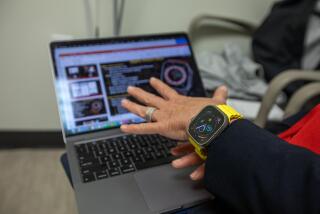Gear: Heart rate monitors, vital sign trackers keep you in the know during workout
Whether you’re 18 or 80, if you like to run, bike, row, swim, cross-country ski or climb mountains, you have to keep an eye on the old ticker — for training and safety purposes. Those aiming for victory have to know how hard to push it; those out for basic health and longevity have to know when to throttle back. And those who take it too far absolutely have to get help fast. Here’s some technology that provides instant access to your vital signs exactly when you and your helpers need it.
Calling your heart rate
Modula Instant Heart Rate app: Available for Android and iPhone smart phones, this is one of the first heart rate monitor apps that does not require any external sensors.
Likes: Your pulse reading is big, clear and seemingly accurate. Easy to use — the heart rate is sensed through the phone’s camera lens. The app reads the slight change in color that occurs when the extra-oxygen-rich blood of a pulse saturates the skin. Works best with a case that does not keep your finger off the lens. The free version displays your pulse numerically; the 99-cent version adds an audible beep, historical charts that can be e-mailed and other features.
Dislikes: Slow (takes 6 seconds to get a reading). The free version does not work well in poor light. Not practical to use while running or doing other exercise. Don’t throw away your old wrist-watch heart-rate monitor.
Price: Free or 99 cents. https://www.instantheartrate.com or https://www.modula.si.
Mr. Medical Gadget
Medicom MP4 Medical Identification Wristband: A 2-gigabyte wrist-top computer with a 1.5-inch screen that stores, displays, voices and transfers your medical history — up to 14 vital medical files in nine languages — to first responders, EMTs and emergency hospital personnel. It also can display time and pictures, as well as play movies, songs or FM radio.
Likes: Peace of mind. This is a big timesaver that could be the difference between life and death. Makes responses to emergencies, such as a bike crash or a heart attack, shorter, personalized and more effective. The data display in an up or down scrolling fashion, pause for easy viewing, and are easily loaded to an ambulance or hospital computer via a USB cable. It’s easy to load all your vital information: physician contact numbers; medical conditions and history; emergency contacts; your medications, dosages and schedules; diet and exercise programs; and more. And when your life’s not on the line, it keeps you entertained.
Dislikes: A bit heavy at 5 ounces.
Price: $115 (leather band), $125 (steel band). (808) 546-5566; medicomtech.com.
Sending out an SOS
LifeTrac Mobile Protector: A 2.5-ounce mobile emergency phone with a GPS locator, a preset 911 button and three other programmable speed-dial buttons for designated pals. If you crash and are knocked out, the GPS signal locates you.
Likes: It ensures that you will be found in the event of an accident or medical crisis. Clips onto pants or can be worn around the neck as a lanyard. It can receive calls too. The GPS provides location updates every five minutes. SOS alerts can be set to go out via Web, e-mail and text. Includes SecuraPAL, which lets your friends receive text-message alerts whenever you drift beyond the virtual borders of your standard run or bike route. It also tracks the movement throughout your workout, allowing you to calculate total distance later by logging on to your account.
Dislikes: Big monetary commitment. Also, the customer support number gave me a recording and instructions to leave a message — never a live person. Not acceptable given the cost.
Price: $187.78 with a monthly fee of $47.99 (you need to sign a two-year service pact); (888) 9-SECURA; https://www.securatrac.com.
Colorful, functional monitor
Bion Blink heart rate monitor: Simple two-button design with tricolored lights that tell you if you are in your desired training zone.
Likes: Essential info, easily accessed. Unlike many of today’s overly complex heart rate monitors with their confounding arrays of buttons, with just two buttons it lets you set and scroll through the basic eight essential functions: elapsed workout time; time in, above and below your desired training zone; peak and average heart rate for your current workout; and total calories burned. Then it provides a way to interpret the signs quickly by linking them to two key physiological markers: threshold heart rate and maximum heart rate. Example: If the lights flash blue, you are exercising at a heart rate pace that is below your target zone. Red is above the zone, and yellow is just right. At the same time, you also have your numerical heart rate. It’s all the info you need — at a glance. Includes a bike handlebar mount and an instruction card on how to set your training zones. Uses an analog transmitter belt, so it works while swimming (digital transmitters don’t work in water).
Dislikes: Analog heart rate monitors can experience cross talk with nearby athletes also using analog.
Price: $79.95. (916) 481-7283; https://www.heartzones.com and https://www.bioninc.com.tw.
Wallack is the author of “Bike for Life: How to Ride to 100” and “Run for Life.”




